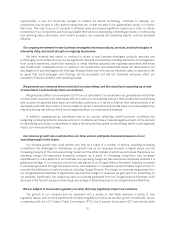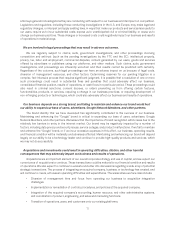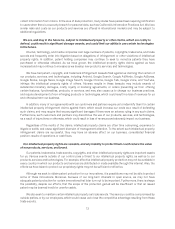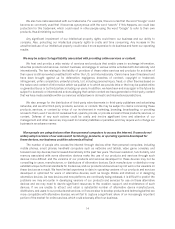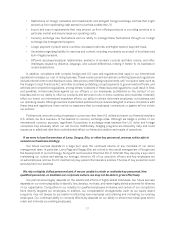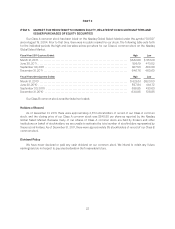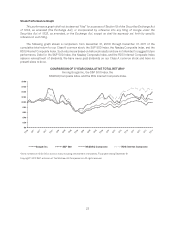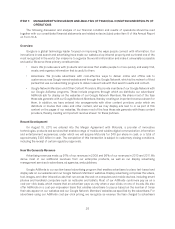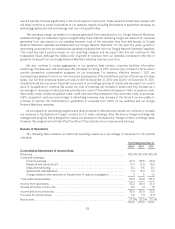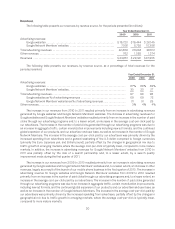Google 2011 Annual Report Download - page 49
Download and view the complete annual report
Please find page 49 of the 2011 Google annual report below. You can navigate through the pages in the report by either clicking on the pages listed below, or by using the keyword search tool below to find specific information within the annual report.• Commentary by industry and market professionals about our products, strategies, and other matters
affecting our business and results, regardless of its accuracy.
• The volume of shares of Class A common stock available for public sale.
• Sales of stock by us or by our stockholders (including sales by our directors, executive officers, and other
employees).
• Short sales, hedging, and other derivative transactions on shares of our Class A common stock (including
derivative transactions under our TSO program).
In addition, the stock market in general, and the market for technology companies in particular, have
experienced extreme price and volume fluctuations that have often been unrelated or disproportionate to the
operating performance of those companies. These broad market and industry factors may harm the market price
of our Class A common stock, regardless of our actual operating performance.
The concentration of our stock ownership limits our stockholders’ ability to influence corporate
matters.
Our Class B common stock has 10 votes per share and our Class A common stock has one vote per share. As
of December 31, 2011, Larry, Sergey, and Eric beneficially owned approximately 92% of our outstanding Class B
common stock, representing approximately 66% of the voting power of our outstanding capital stock. Larry,
Sergey, and Eric therefore have significant influence over management and affairs and over all matters requiring
stockholder approval, including the election of directors and significant corporate transactions, such as a merger
or other sale of our company or our assets, for the foreseeable future. This concentrated control limits our
stockholders’ ability to influence corporate matters and, as a result, we may take actions that our stockholders do
not view as beneficial. As a result, the market price of our Class A common stock could be adversely affected.
Provisions in our charter documents and under Delaware law could discourage a takeover that
stockholders may consider favorable.
Provisions in our certificate of incorporation and bylaws may have the effect of delaying or preventing a
change of control or changes in our management. These provisions include the following:
• Our certificate of incorporation provides for a dual class common stock structure. As a result of this
structure, Larry, Sergey, and Eric have significant influence over all matters requiring stockholder
approval, including the election of directors and significant corporate transactions, such as a merger or
other sale of our company or our assets. This concentrated control could discourage others from
initiating any potential merger, takeover, or other change of control transaction that other stockholders
may view as beneficial.
• Our board of directors has the right to elect directors to fill a vacancy created by the expansion of the
board of directors or the resignation, death, or removal of a director, which prevents stockholders from
being able to fill vacancies on our board of directors.
• Our stockholders may not act by written consent. As a result, a holder, or holders, controlling a majority of
our capital stock would not be able to take certain actions without holding a stockholders’ meeting.
• Our certificate of incorporation prohibits cumulative voting in the election of directors. This limits the
ability of minority stockholders to elect director candidates.
• Stockholders must provide advance notice to nominate individuals for election to the board of directors or
to propose matters that can be acted upon at a stockholders’ meeting. These provisions may discourage
or deter a potential acquirer from conducting a solicitation of proxies to elect the acquirer’s own slate of
directors or otherwise attempting to obtain control of our company.
20


